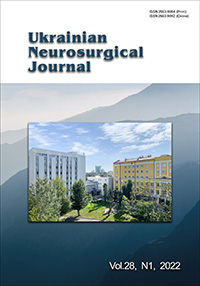Reconstructive plastic surgery in patients with complex defects and deformities of the head when removing extracerebral tumors extending beyond the cerebral skull
DOI:
https://doi.org/10.25305/unj.236139Keywords:
computer simulation, tumors, complex defects of head tissues, surgical treatmentAbstract
Objective: To improve the surgical results of neurosurgical patients with complex defects and deformities of the head based on modern innovative technologies.
Маterials and methods. Based on the analysis of diagnosis and surgical treatment of 54 patients with common extracerebral tumors of the head the issues of optimizing their treatment were considered. The positive role of reconstructive-plastic operations in complex defects and deformities of the head on the basis of modern possibilities of computer modeling and use of arterial autografts is noted.
Results. Carrying out computer simulations before the operation, radical removal of the tumor with a single-stage reconstructive-plastic operations with the use of innovative technologies provides high efficiency of treatment, satisfactory quality of life of patients.
Conclusions. Reconstructive plastic surgery in patients with complex defects and deformities of the head when removing extracerebral tumors that extend beyond the cerebral skull, can provide a satisfactory functional and cosmetic effect of the operation. Radical removal of the tumor by a single-stage autologous tissue grafting using modern technologies promotes rapid wound healing and good quality of life. In patients with widespread cancer stages of the skull, for the plasty of complex soft tissue defects of the cranial vault, the optimal operation is the use of regional musculocutaneous flaps. The type, shape and required amount of the tissue depends on the size and location of the defect. It has been confirmed that the use of a horizontal D-shaped musculocutaneous flap is justified for temporal and parietal defect plasty, and the use of a vertical D-shaped musculocutaneous flap is required to close the occipital-parietal defect. The use of computer simulation is effective and appropriate in patients with large defects and deformities of the cerebral and facial skull when planning complex reconstructive plastic surgery. The use of modified surgical approaches, the latest innovative technologies has made it possible to significantly improve the quality of life of patients, contributed to their early rehabilitation and readaptation.
References
Kvasha МS, Zhernov АA, Molotkovets VY, Kvasha EM, Ukrainets OV, Dashchakovskyi AV, Mosiychuk SS. Rekonstruktsiya skladnykh defektiv m’yakykh tkanyn sklepinnya cherepu u neyroonkolohichnykh khvorykh [Reconstructionofcomplex defects of soft tissues of the arch of the skull in neuronecological patients]. Ukrainian Neurosurgicil Journal. 2017;3:24-29. Ukrainian. doi:10.25305/unj.112099.
Kopchak AV. Zastosuvannya metodiv komp’yuternoho modelyuvannya pry planuvanni khirurhichnykh vtruchan u patsiyentiv z travmatychnymy perelomamy nyzhn’oyi shchelepy [Application of computer simulation methods in planning of surgical interventions in patients with traumatic fractures of the mandible]. Plastychna, rekonstruktyvna i estetychna khirurhiya. 2014;1-2:21-29.Ukrainian.
Malanchuk VO, Kryshchuk MH, Kopchak AV. Imitatsiyne komp’yuterne modelyuvannya v shchelepno-lytseviy khirurhiyi [Simulation Computer Modeling in Maxillofacial Surgery]. Kyiv: Vydavnychyy dim «Askaniya; 2013. 231 p. Ukrainian.
Protsyk VS, Kravets OV, Trembach AM, Korobko EV, Mosyn OA., Chychula RE. Rekonstruktivno-vosstanovitel'nyye operatsii v khirurgii mestno-rasprostranennykh zlokachestvennykh opukholey golovy i shei [Reconstructive-reduction operations in the surgery of locally advanced malignant tumors of the head and neck]. Klinicheskaya onkologiya. 2011;1(1): 62-66. Russian.
Sokolov VM, Mytchenok VI, Avetikov DS. Shchelepno-lytseva Khirurhiya. Rekonstruktyvna khirurhiya holovy ta shyyi [Reconstructive surgery of the head and neck]. Vinnytsya: Novaknyha; 2006. 116 p. Ukrainian.
Chuyko AN, Shinchukovskiy IA. Biomekhanika v stomatologii [Biomechanics in dentistry]. Khar'kov: Fort; 2010. 466 s. Russian.
Can A, Orgill DP, Dietmar Ulrich JO, Mureau MA. The myocutaneous trapezius flap revisited: a treatment algorithm for optimal surgical outcomes based on 43 flap reconstructions. J Plast Reconstr Aesthet Surg. 2014 Dec;67(12):1669-79. doi: 10.1016/j.bjps.2014.07.044.
Ou KL, Dai YH, Wang HJ, Chen TM, Dai NT, Chang SC, Deng SC, Tzeng YS, Wang CH, Chen SG. The lower trapezius musculocutaneous flap for head and neck reconstruction: two decades of clinical experience. Ann Plast Surg. 2013 Dec;71 Suppl 1:S 48-54. doi: 10.1097/SAP.0000000000000036.
Sugar AW, Ehrenfeld M, editors. Imagin gandplanning in surgery: a guide to research. Switzerland: AO Publishing; 2008. 134 p.
Yang HJ, Lee DH, Kim YW, Lee SG, Cheon YW. The Trapezius Muscle Flap: A Viable Alternative for Posterior Scalp and Neck Reconstruction. Arch Plast Surg. 2016 Nov;43(6):529-535. doi: 10.5999/aps.2016.43.6.529.
Downloads
Published
How to Cite
Issue
Section
License
Copyright (c) 2022 Tenhiz А. Morozov, Michail S. Kvasha

This work is licensed under a Creative Commons Attribution 4.0 International License.
Ukrainian Neurosurgical Journal abides by the CREATIVE COMMONS copyright rights and permissions for open access journals.
Authors, who are published in this Journal, agree to the following conditions:
1. The authors reserve the right to authorship of the work and pass the first publication right of this work to the Journal under the terms of Creative Commons Attribution License, which allows others to freely distribute the published research with the obligatory reference to the authors of the original work and the first publication of the work in this Journal.
2. The authors have the right to conclude separate supplement agreements that relate to non-exclusive work distribution in the form of which it has been published by the Journal (for example, to upload the work to the online storage of the Journal or publish it as part of a monograph), provided that the reference to the first publication of the work in this Journal is included.









